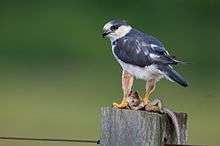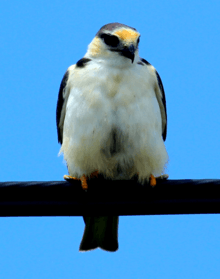Pearl kite
The pearl kite (Gampsonyx swainsonii) is a very small raptor found in open savanna habitat adjacent to deciduous woodland. It is the only member of the genus Gampsonyx. The scientific name commemorates the English naturalist William Swainson.
| Pearl kite | |
|---|---|
 | |
| Pearl Kite in savannah | |
| Scientific classification | |
| Kingdom: | Animalia |
| Phylum: | Chordata |
| Class: | Aves |
| Order: | Accipitriformes |
| Family: | Accipitridae |
| Genus: | Gampsonyx Vigors, 1825 |
| Species: | G. swainsonii |
| Binomial name | |
| Gampsonyx swainsonii Vigors, 1825 | |
Taxonomy and systematics
The type specimen was collected from Brazil by English naturalist William Swainson, and described by Nicholas Aylward Vigors in 1825.[2] Vigors noted the similarity to both hawks and falcons, but placed Gampsonyx within the "Accipitrine subfamily" because it lacks the notched beak of the falcons. He also noted its striking resemblance to the coloration of the falconets.
Later, the pearl kite was classified with the falcons. For example, Peters[3](pxviii)(p281) placed it with the forest falcons in subfamily Polyhieracinae. In the mid-20th century it was found to be related to Elanus based on morphology and its molt schedule.[4]
Distribution and habitat
This tiny kite breeds from Panama, Colombia and Venezuela south to Bolivia and northern Argentina, with an isolated sedentary population in Nicaragua. It is expanding its range and was proved to breed on Trinidad in 1970. It was first reported in Costa Rica in the mid-1990s, and now is fairly common along Pacific slope, to 1000m.[5]
Description

The pearl kite is 20.3–23 cm (8.0–9.1 in) in length and weighs 80–95 g (2.8–3.4 oz). It is the smallest raptor in the Americas and one of the two smallest accipitrids in the world (besides the little sparrowhawk). The tiny hawk, another neotropical species, attains a slightly higher weight than the pearl kite. The adult has a black crown, upperparts, wing and tail, a rufous edged white collar, yellow forehead and cheeks, mainly white underparts, and yellow legs. Immature birds are similar to the adults but have white and chestnut tips to the back and wing feathers, a buff collar and some buff on the white underparts. In flight this species looks mainly black above and white below. The northern form G. s. leonae differs from the nominate G. s. swainsonii in that it has rufous flanks.
Behaviour
Breeding
The nest is a deep cup of sticks built high in a tree. The clutch is 2-4 brown-marked white eggs, incubated mainly by the female for 34–35 days to hatching, with a further 5 weeks to fledging. There may be two broods in a season.
Notes
References
- BirdLife International (2012). "Gampsonyx swainsonii". IUCN Red List of Threatened Species. 2012. Retrieved 26 November 2013.CS1 maint: ref=harv (link)
- Vigors, Nicholas Aylward (April 1825). "On a new genus of Falconidæ". Sketches in Ornithology. The Zoological Journal. 2 (5): 65–70. The description of G. swainsonii is on pages 68–70, formal Latin description begins on p. 69. Biodiversity Heritage Library holds two digitized copies: one from London Museum of Natural History , and the other from Smithsonian Libraries
- Peters, James Lee (1931). Check-list of birds of the world: volume 1. Cambridge, Mass., U.S.A.: Harvard University Press.
- Baquero Palma, Fernando Hernandez (2011). "Species account: Pearl Kite Gampsonyx swainsonii". Global Raptor Information Network. Archived from the original on 2011-11-19. Retrieved 25 October 2014.
- Garrigues, Richard; Dean, Robert (illustr.) (2007). The birds of Costa Rica : a field guide. Ithaca: Comstock Publ. ISBN 978-0-8014-7373-9.
- Hilty, Steven L. (2003). Birds of Venezuela. London: Christopher Helm. ISBN 0-7136-6418-5.
- ffrench, Richard (1991). A Guide to the Birds of Trinidad and Tobago (2nd ed.). Comstock Publishing. ISBN 0-8014-9792-2.
- Stiles, F. Gary; Skutch, Alexander F. (1989). A guide to the birds of Costa Rica. Ithaca, N.Y.: Comstock. ISBN 0-8014-9600-4.
External links
| Wikimedia Commons has media related to Gampsonyx swainsonii. |
| Wikispecies has information related to Gampsonyx swainsonii |
- Pearl Kite videos on the Internet Bird Collection
- Pearl Kite photo gallery VIREO Photo-High Res
- "Gampsonyx swainsonii". Avibase.

- Gampsonyx swainsonii in the Flickr: Field Guide Birds of the World
- Illustration, plate IX in The Genera of Birds, 2ed. vol. 1 (G. R. Gray, 1849)
- Synonymy in Catalogue of the Accipitres or Diurnal Birds of Prey in the British Museum, (Sharpe 1874).
